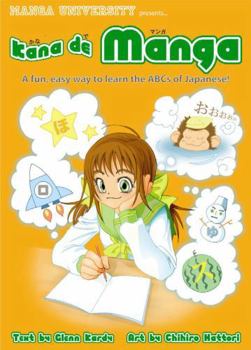Kana de Manga: The Fun, Easy Way to Learn the ABCs of Japanese
Kana de Manga, the latest entry in the popular Manga University lineup of books, uses original manga artwork to teach students how to read, write and pronounce the Japanese hiragana and katakana alphabets, also known as "kana." Author Glenn Kardy, editor of several of the English-language volumes in the world-renowned How to Draw Manga series, and artist Chihiro Hattori have teamed up to create this must-have book for manga enthusiasts...
Format:Paperback
Language:English
ISBN:4921205019
ISBN13:9784921205010
Release Date:March 2005
Publisher:Japanime Co.
Length:144 Pages
Weight:0.35 lbs.
Dimensions:0.3" x 5.2" x 7.1"
Age Range:13 to 16 years
Grade Range:Grades 8 to 11
Customer Reviews
6 ratings
good
Published by UwU , 4 years ago
it was ok. if i wanted to re-use it, id have to erase my wrighting on all the pages. and less pages than i expected
great tool, learned all the basic Hiragana and Katakana very quickly...
Published by Thriftbooks.com User , 18 years ago
I was looking around for a book that would teach me to read and write Katakana and Hiragana, and I stumpled across this book. Kana de manga really isn't lying when they say the little pictures in the book help you to learn. The overall layout of the book was great, and the practice section was really well done. If you need to learn katakana and hiragana, then this is the book for you.
Nihongo's ABCs
Published by Thriftbooks.com User , 18 years ago
I purchased this book at the store upon seeing it online. I thought, "Wow! Japanese is sooo cool! I should get this!" so I did. Let me tell you, it was (and is!) great. Not only do you learn all the characters of the two alphabets, but you learn many words as well. The character is used in a word, and the romanji and english translations are included. In the paragraph on each page, it usually names a few words as well. The paragraphs also include a bit of information about the actual country. The illustrations are very cute, and relate to the words given. Though the accented characters are not introduced, it's not THAT hard to figure out. It just takes some of the previously learned characters, adds accents, and TADA! It becomes a new character. I hope to someday become fluent in Japanese. I realize that I have learned a LOT from this book. If you, yes you, reading this message want to become fluent in Japanese for WHATEVER reason, buy this book. It is the first step on your way to bridge the gaps between language (or to just have some fun with a new hobby ^_~)
A good entry point to the kana for the tween-ager set
Published by Thriftbooks.com User , 19 years ago
One kana character per page spread (hirigana on the left side of each spread, katakana on the right); a sample word using the kana on each page; a paragraph putting the word in cultural context; and a manga-style illustration. It's a simple and effective formula... much the same one as used in Jimi's Book of Japanese, which we purchased last year. However, Kana de Manga appeals to a slightly older kid. My 12-year-old daughter declares herself very pleased with it. "Jimi" is a larger book, much more nicely produced (glossy paper, heavy cover, color) but seems pitched at the younger set. Also, you have to buy separate Jimi books for hirigana and katakana; this one combines both in one volume. I particularly appreciated the fact that the hirigana words were mostly Japanese words, whereas the katakana examples were typically foreign loan words--reinforcing the fact that this is how the two syllabaries are used in real-life Japanese. Considering that my kiddo has had the book only two days and is already telling me that "kiku" is chrysanthemum and yon-yon (4th day 4th month, or April 4) is Yo-Yo Day in Japan, I think I can safely say the book was a good investment. Oh, about the "is it complete or is it not?" debate between previous reviewers--they're both wrong :-) The kana characters, when modified with the dakuten (two little lines) or handakuten (tiny circle), do indeed become different "letters" (really syllables), just as an N (en) and an N-tilde (enye) are two different letters in Spanish. The page-by-page treatment in this book covers only the basic 46 kana characters. However, the introductory material covers the use of the diacritical marks (dakuten changes K->G, S->Z, T->D, and so on; handakuten changes H->P). It also touches on doubled vowels and consonants. <br /> <br />Personally, I'd have liked to see these modified characters get their own pages--it's one thing to say "oh, and apply this rule to get that" but much better would be to show examples of the rule. But it's not a deal-breaker, especially for a book priced under ten bux.
Excellent for learning Japanese!
Published by Thriftbooks.com User , 19 years ago
This is literally the 'ABC's' of Japanese. It is very helpful, and I can actually read Japanese now! (Well almost...) This is a great book to get before Kanji de Manga, because you need to know the Hiragana and Katakana before moving on. So if you're interested in learning how to read and write Japanese, definitely get this book.
This book has ALL of the kana characters
Published by Thriftbooks.com User , 19 years ago
The person who said this book only has half the hiragana and katakana characters is wrong. This book has 46 hiragana characters and 46 katakana characters, which is all of them!





